You all know Jökulsárlón. It’s the glacial lagoon, the one with the icebergs floating around. Outside of the south-west, the likes of the Golden Circle and the Blue Lagoon, it’s Iceland’s most visited sight. In a very photogenic country, this is a particularly beautiful one.

Let’s have a quick Icelandic lesson, because Icelandic words seem to terrify tourists, which is why this place is so much better known as “the glacier lagoon”. Jökulsárlón is pronounced, approximately, “Yer-kul-sowr-lohn”, that last “o” being the same as the one in “hotel”. Jökul- means glacier, -á means river and lón is lagoon, making this “glacier’s river lagoon”. We cut out the river in English.
It’s 240 miles from Reykjavik, a drive of nearly five hours non-stop. If you have your own car, you really should take the entire day to enjoy the scenery, the waterfalls and the various other joys of the south coast and stay out east overnight rather than try to get there and back in a day. Even better, it’s an unmissable stop on a self-drive Ring Road itinerary.
If you don’t have a car, you can do Reykjavik Excursion’s 15 hour Glacial Lagoon & Diamond Beach tour or Grayline’s Jökulsárlón 14 hour Glacier Lagoon Tour or Arctic Adventures’ 14-16 hour South Coast, Jokulsarlon & Diamond Beach Day Tour from Reykjavik. All, as that last suggests, from Reykjavik and all, as you can see, long days. If you’re already at Skaftafell, Arctic Adventures do a variety of shorter trips leaving from the National Park visitor centre. Mine, in 2012, included a be-cramponed glacier hike before a ride around the edge of the ice cap to the lagoon in a yellow American school bus from eBay.
Or there’s public bus no 51, which unhelpfully departs from Mjódd, Reykjavik’s bus station which is ludicrously difficult to get to from downtown Reykjavik where the tourists tend to be (take the 11 from the bottom of Hverfisgata, 12:17 – 12:42 or the 3 from outside Harpa, 12:25 – 12:49, although I’d personally be on an earlier bus to make sure I don’t miss the 51 through Reykjavik traffic). The 51 departs at 13:00 and reaches Jökulsárlón at 19:05. The bus back departs Jökulsárlón at 12:55 the next day and gets to Mjódd at 18:45 so you’ll need to stay overnight somewhere. There isn’t any accommodation at Jökulsárlón so it would be better to take the bus to Skaftafell (arrives 18:20, departs 13:49) and arrange travel from there through one of the companies that operates from the visitor centre. Wild camping is illegal in Iceland so you can’t just pitch your tent next to the lagoon, by the way. Be a good and considerate tourist.
RE used to run a network of long-distance buses from the BSÍ terminal downtown but that all seems to be long gone, which is a genuine shame because it was really useful and really easy, especially paired with their collection of “bus passports”.
All in all, driving yourself is just the most convenient way to get there.

When you arrive, there’s a big car park on the lateral moraine east of the lagoon, just on the other side of the bridge that crosses the river. It’ll be busy during the afternoon, what with all the tour buses and tourists who’ve spent the morning driving out from Reykjavik. I went in the evening in 2016, after a long day stopping all along the south coast and pitching my tent at Skaftafell, arriving as the sun was…. well, not setting. It was July and the sun doesn’t set. But it was in the west rather than directly overhead, and the lower sun was pretty on the icebergs.

Boats run on the lagoon during summer – the amphibious boats (5,900 ISK) appear to start from May 1st and run through to mid-November and the Zodiacs (10,500ISK), which are ex-military RIBs, run from mid-May to mid-October although I can’t see any availability on either until next May now. You’ll need to book in advance online – once upon a time you could turn up and get on the next boat but with the increase in tourists, things get filled up before you’ve ever thought of going there. The amphibious boats run about every hour, with a break for lunch and the last one is at 17:30 and the Zodiacs go about every two hours with the last one at 17:50, so good luck if you’re there on the public bus.

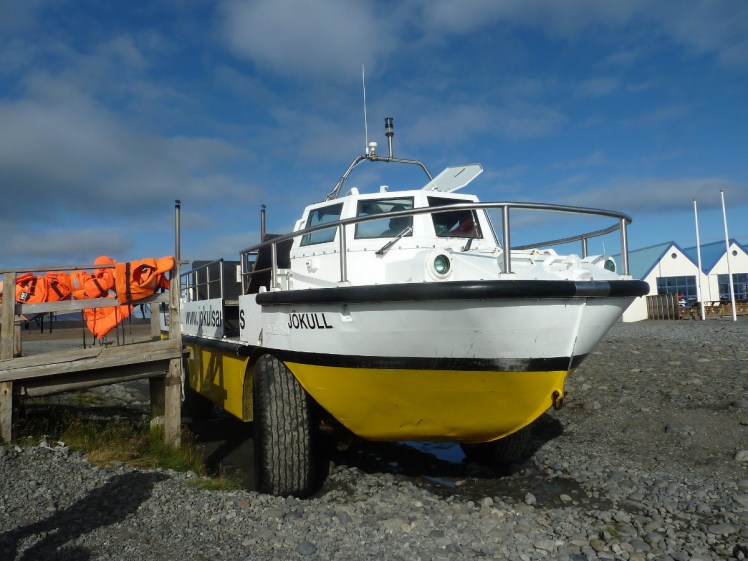
I’ve not done the Zodiac tour but I’ve done the amphibious boats twice. They’re great. They’re big open-topped things that you board via a pier at the end of the car park, then they trundle across the gravel and down into the water, where you think for half a second that the whole contraption is going to sink before the floating takes over. You get 30-40 minutes of puttering around the icebergs and usually a guard boat will supply a piece of crystal-clear glacier ice to your guide, who will chip it into pieces for you to taste. You can’t go to the glacier, not in the amphibian boats. Believe it or not, it’s five miles down that lagoon and those boats are built for power, not speed. They can haul you up onto solid land but they can’t get down to the far end of the lagoon in an hour The Zodiacs might take you down there, though, if conditions are suitable.
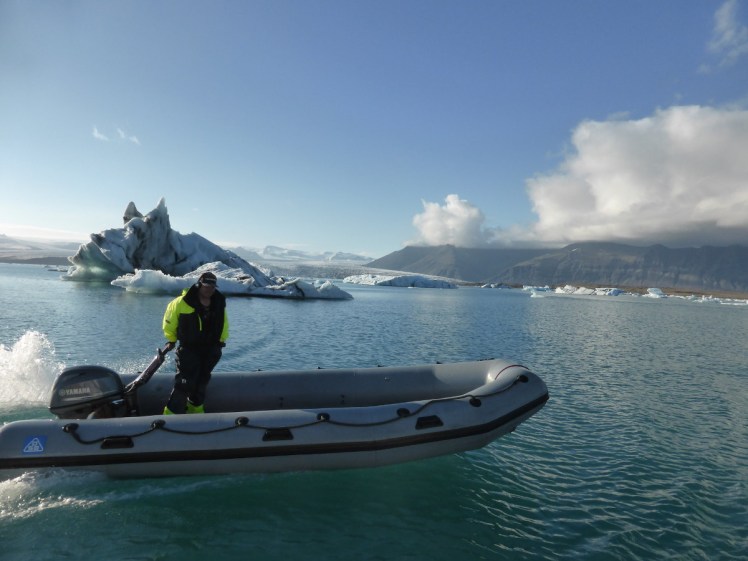
Yeah, the lagoon is big. Five miles from the road bridge to the glacier which is producing all the icebergs. Its name is Breiðamerkurjökull (bray-tha-mare-kur-yer-kertl) and it’s a tongue of Vatnajökull, the vast ice cap that dominates this region. It’s in retreat now, and a good thing it is. You see, Jökulsárlón is an embryonic fjord. The lagoon has been carved by the sheer weight of ice and it cuts well below the level of the bottom of the sea just on the other side of that road bridge. While the lagoon is connected to the North Atlantic by a small river, it hasn’t actually broken through the land. If it did, the lagoon would fill up with sea water and you’d have a fjord. At the moment, Jökulsárlón is walled off from the ocean by its terminal moraines, the mounds of grit and rock and general dirt deposited right in front of the end of its snout. If the glacier had continued to grow, it would have cut through that last half a mile of solid land and there would be no lagoon. It’s taken me decades to figure out what the difference is between a fjord and any old bay or inlet, and it’s the glacier-carving. Fjords are terrifyingly deep. Jökulsárlón is, at its deepest, 284m deep. To use my favourite tired old simile, One Canada Square, better but incorrectly known as Canary Wharf, would be completely submerged, even the flashing light on its pyramid lost in the depths.

Just out of morbid interest, if you fell off your boat, or it sank, you’d probably die of cold shock before you had the chance to drown. They give you big bulky buoyancy aids and you may get actual lifejackets on the Zodiac adventures.
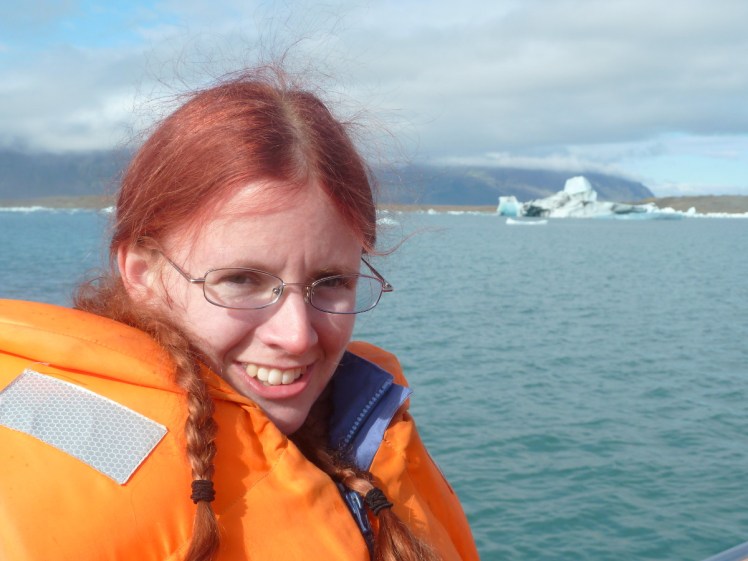
And on the subject of dying in the waters, sometimes tourists enjoy climbing onto icebergs if they drift close enough to shore. This is an incredibly dangerous thing to do. Icebergs are very carefully balanced, floating with the majority of their mass below the surface. The bit above the water gets slowly melted and shrunk by the sun and the bit under the water gets melted by the relatively warm water it’s in. Then it gets off balance and then the whole thing can flip upside down. You’d think with something the size of a house that it would be a slow graceful process. It isn’t. It happens with no warning and takes seconds to complete the somersault, a huge mass of ice and water flung suddenly upwards and suddenly downwards, crashing back into the lagoon with a minor tidal wave. If you’re sitting on it at the time, you may not survive the experience. Don’t do it. The boats know and understand the danger well, which is why you’ll notice the amphibian boats don’t go nearer the icebergs than is strictly necessary and the Zodiacs are careful and thoughtful about how close they get to the glacier.
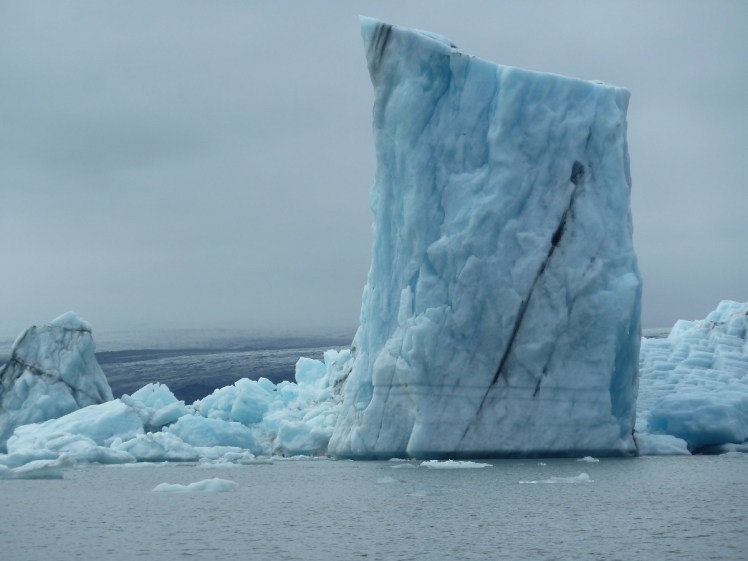
From this distance, the glacier, or at least the bit trailing in the water, looks tiny. I’ve not seen it up close but the snout, where it meets the water, has to be a reasonable height. Look at the size of the icebergs breaking off it. Now imagine being in a rubber boat when that falls off the front of the glacier. Imagine the ice falling on you, imagine the wave nearly turning the boat over. Terrifying things, glaciers. Remember how it’s carved a lagoon 284m deep? Think how much glacier you can’t see below the water level.
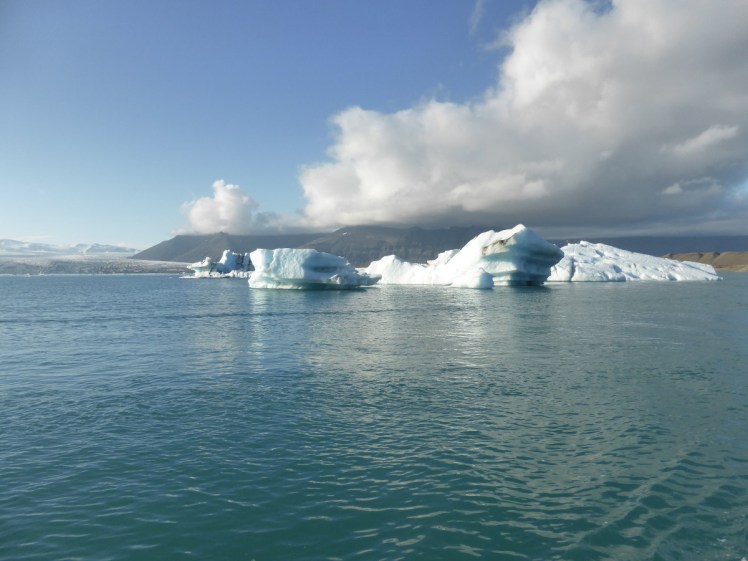
But it’s pretty, especially seen from the shore in the evening, blue-and-white striped icebergs drifting silently, seals popping up, seabirds swooping around.

Do you know why the icebergs are stripy? The blue stripes are winter ice; the extra weight of all that fresh snow compressing all the air bubbles out and leaving the ice completely pure. The white stripes are summer ice, not so heavy, not so compressed, air bubbles left. The light within the ice bounces differently, showing different colours to the human eye. Ice you make in your own freezer will be even whiter. I can’t explain it better than that. I’m already playing geography and Icelandic teacher in this post and I’ve had a shot at nuclear physicist/chemist before. I can’t be an optical physicist too. Refraction? Defraction? Something about how prisms split light, anyway. More bouncing = white appearance, less bouncing = blue appearance.

You might also notice narrower grey-black stripes in the ice. Those are layers of ash dropped on the glacier by its neighbour, Eyjafjallajökull, during her 2010 eruption. They were quickly sealed into the glacier’s layers by fresh snow on top. Yes, what I’m saying is that you can, in theory, age a glacier by counting the rings. Except that the underneath layers will get well and truly crushed and it’ll all get twisted and kneaded by the movement as it falls in ultra-slow motion off the mountain.

When you’ve had your fill of the scenery and the living geography lesson, go into the cafe for waffles and rhubarb jam. At least, I think it’s rhubarb jam. I didn’t know exactly what it was at the time and Google hasn’t been all that helpful. I don’t even eat normal people food and I remember that meal fondly. The jam is a bit brown, because it hasn’t been dyed bright red like mass produced supermarket jam, and it’s a bit sharper than I’m used to but it goes very well with very hot fresh flower-shaped waffles. The cafe also, unsurprisingly, does various seafood things but that’s not really my area.
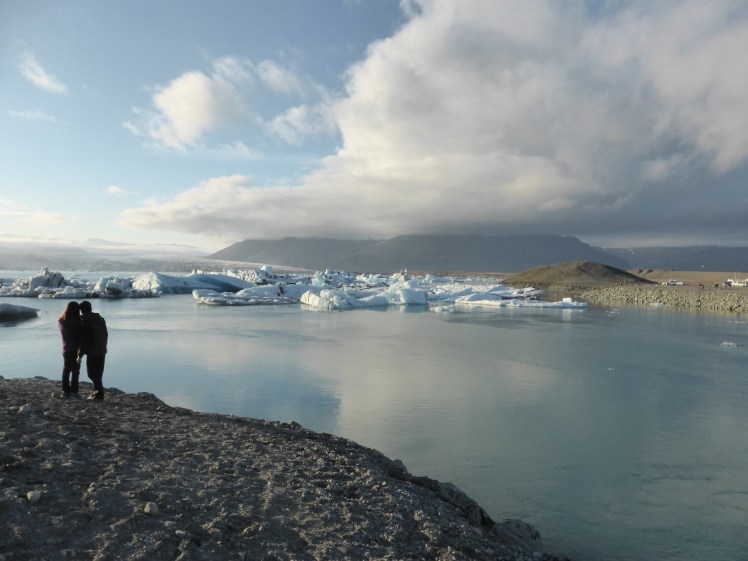
I’ve only been to Jökulsárlón in the summer but I bet seeing the Northern Lights over it in winter is beyond amazing and I’ve also seen pictures of fireworks displays reflected in the water. But of course, it’s beautiful all year round and absolutely worth a stop if you’re venturing beyond Reykjavik.
One thought on “The Icelandic Guidebook: Jökulsárlón”